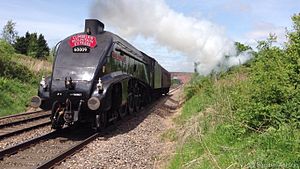LNER Class A4 4488 Union of South Africa

Union of South Africa passes Condover
|
|||||||||||||||||||||||||
|
|||||||||||||||||||||||||
|
|||||||||||||||||||||||||
|
|||||||||||||||||||||||||
|
|||||||||||||||||||||||||
| Type and origin | |
|---|---|
| Power type | Steam |
| Designer | Nigel Gresley |
| Builder | LNER |
| Serial number | 1853 |
| Build date | June 1937 |
| Specifications | |
|---|---|
| Configuration | 4-6-2 |
| UIC class | 2'C1h3 |
| Gauge | 4 ft 8 1⁄2 in (1,435 mm) |
| Leading dia. | 3 ft 2 in (0.965 m) |
| Driver dia. | 6 ft 8 in (2.032 m) |
| Trailing dia. | 3 ft 8 in (1.118 m) |
| Boiler pressure | 250 psi (1.72 MPa) |
| Cylinders | Three |
| Cylinder size | 18.5 in × 26 in (470 mm × 660 mm) |
| Loco brake | Vacuum |
| Train brakes | LNER/BR: Vacuum Now: Air and Vacuum |
| Performance figures | |
|---|---|
| Tractive effort | 35,455 lbf (157.7 kN) |
| Career | |
|---|---|
| Operators | LNER, BR |
| Class | A4 |
| Number in class | 15 of 35 |
| Numbers | LNER: 4488, LNER: 9, BR: 60009 |
| Official name | Union of South Africa |
| Current owner | John Cameron |
| Disposition | Operational and certified for use on Network Rail |
60009 Union of South Africa is an LNER Class A4 steam locomotive built in Doncaster in 1937. It is one of six surviving Gresley A4s, currently operational and mainline certified. It was briefly renamed Osprey during 1990–91 due to political opposition against apartheid South Africa at the time.
Built by the London and North Eastern Railway (LNER) in 1937 at Doncaster and originally numbered 4488, it was named after the then newly formed Union of South Africa. It had previously been allocated the name Osprey on 17 April 1937, but was renamed Union of South Africa to operate the Coronation streamlined train. It eventually carried the name Osprey from 1990–91. This was due to the contemporary political opposition against South Africa, which undertook a controversial policy of racial apartheid from 1948–94. The name Osprey had previously been carried by A4 No. 4494 (renamed after the LNER director Andrew K. McCosh after 1942) and LNER Peppercorn Class A1 No. 60131 from 1949–65. 60009's name has since reverted to Union of South Africa. The works number was 1853; the plaques are located in the cab itself and not on the exterior cab sides as is the usual practice.
The springbok plaque on the side of the locomotive was donated on 12 April 1954 by a Bloemfontein newspaper proprietor. Only the one plaque was fitted on the left hand side of the locomotive. Two cast Springbok plaques were given to John Cameron in the mid 1970s and these were mounted on the cabsides. They have since been removed during overhauls but the original boiler side plaque remains. 60009 is fitted with an American, Crosby chime whistle in common with other members of its class.
Union of South Africa has worn many liveries throughout her career. The first livery she wore was as 4488 in garter blue, applied on 19 April 1937. The next livery applied was LNER wartime black on 21 March 1942. This livery was amended on 14 August 1943 when the "L" and "R" were removed to confuse potential spies, leaving the all-black locomotive with just "NE" on the tender. 21 February 1947 saw Union of South Africa regain garter blue with red and white lining. Her number was changed to just "9" on 12 January 1946, under the renumbering scheme of Gresley's successor, Edward Thompson. She gained a stainless steel number 9 during this repaint. 4 August 1949 saw 60009 applied with the standard British Railways express passenger blue livery (as 60007 Sir Nigel Gresley is wearing currently in 2008). Finally on 2 October 1952, Union of South Africa was painted in British Railways brunswick green livery. She has worn this livery throughout preservation to date.
...
Wikipedia
